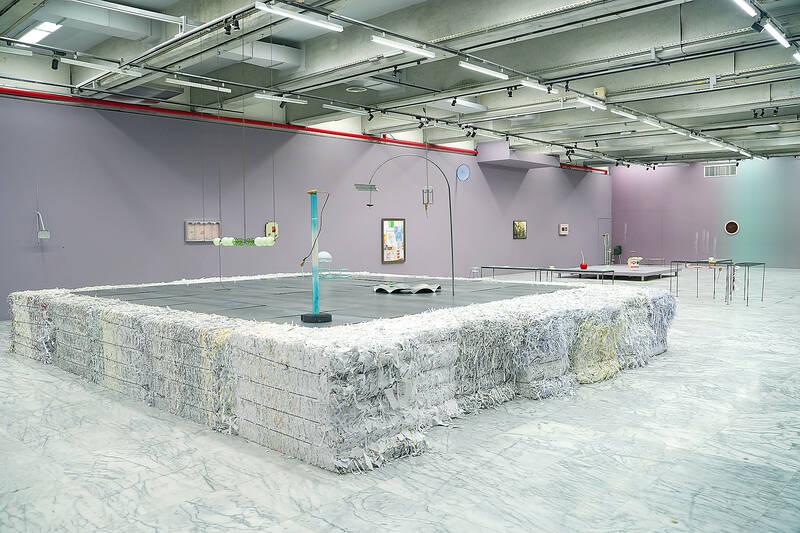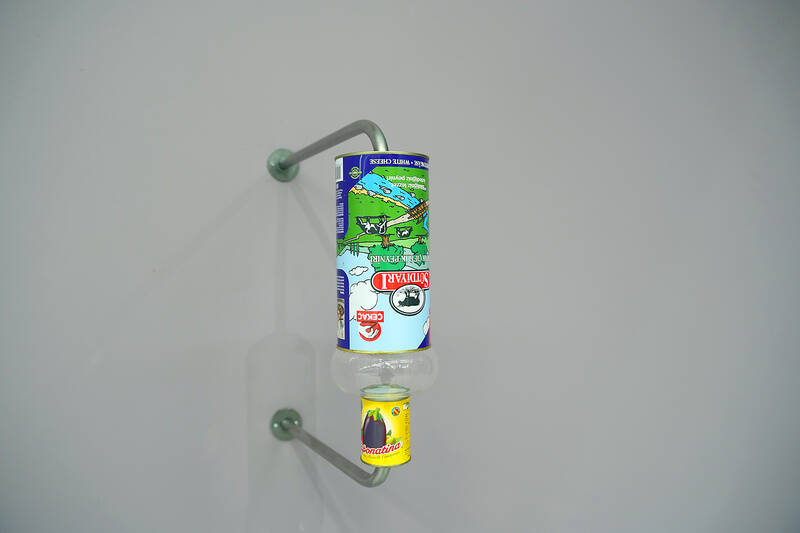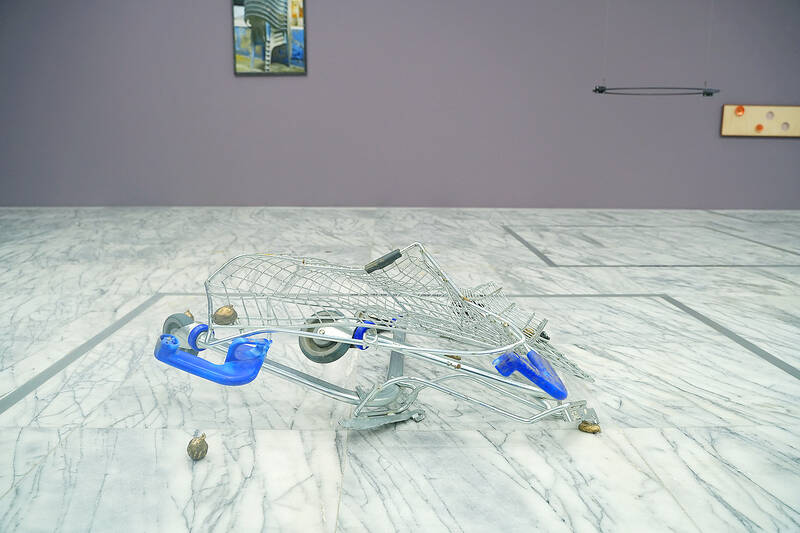On the lowest floor of the Taipei Fine Arts Museum (TFAM), a large room contains household items from coffee cans and wrapping paper to a mangled shopping cart. This is Lili Deli, the latest exhibition by multi-disciplinary artist Steph Huang (黃麗音).
The London-based Huang deftly blends painting, photography and sculpture to comment on mass production, commerce and consumerism.
There are platforms the size of small cars made entirely of shredded paper, a cherry made of hand-blown glass, a painting of a shopping cart drowning as though it is part of a Monet painting and more.

Photo: Lery Hiciano, Taipei Times
THROW-AWAY CULTURE
Huang has had several exhibitions satirizing and lampooning our contemporary obsession with buying more than we need and wasting more than the planet can handle.
“I am always aware of capitalism and consumerism in my work by engaging with materials from the capitalist world,” Huang told the Taipei Times.

Photo: Lery Hiciano, Taipei Times
In particular, she focuses on how speed, efficiency and affordability are prioritized in our society.
Upon walking into Lili Deli, visitors are greeted by a large platform of shredded paper with several art pieces on top of it, including Ride the Wave, made out of a horseradish root tube.
On another platform, a repurposed coffee can from the Netherlands and a human-sized paper clip stand tall, divorced from their original context.

Photo: Lery Hiciano, Taipei Times
URBAN DETRITUS
Huang describes her process as actively seeking out items left behind in urban areas, then gathering them in her studio, “waiting for their moment.”
What ties all these objects together? They once mattered, or functioned, or served some purpose far removed from being centerpieces at an art exhibit in Taipei — their commercial usefulness expiring, to be reimagined as part of an ongoing commentary on the need to consciously reconsider our own consumption habits.
Each piece is ambiguous yet familiar, readily willing to accept a viewer’s projections.
The shopping cart, dug out of a landfill in Scotland, looks like one that anyone would use in a supermarket, and the can of coffee grounds evokes memories of grandma with her morning cup of joe.
Yet each piece, by virtue of its placement in the gallery is puzzling, cryptic and obscure in its meaning.
It is strange to see household items in such a place, to try and figure out what type of household the item already came from or, in some cases, deduce what item it was and what its original purpose could have been.
“These works hold the potential to resonate with a wide audience, as many of the works are transformations of trivial day-to-day living experiences,” Huang said.
At the same time, she says that different countries where her work has been shown lead to different audience reactions, a “gap.” One work that is under construction is Lili Deli’s Tower of Freebies Project, where visitors are invited to bring unwanted items from home and deposit them to create a makeshift, collaborative monument.
At the end of the exhibition’s run in June, the tower’s items will then be distributed to interested parties, who can hopefully find more use or meaning in them than those who first abandoned them.
“I would love to see the tower reach its full potential,” she said.

Wooden houses wedged between concrete, crumbling brick facades with roofs gaping to the sky, and tiled art deco buildings down narrow alleyways: Taichung Central District’s (中區) aging architecture reveals both the allure and reality of the old downtown. From Indigenous settlement to capital under Qing Dynasty rule through to Japanese colonization, Taichung’s Central District holds a long and layered history. The bygone beauty of its streets once earned it the nickname “Little Kyoto.” Since the late eighties, however, the shifting of economic and government centers westward signaled a gradual decline in the area’s evolving fortunes. With the regeneration of the once

Even by the standards of Ukraine’s International Legion, which comprises volunteers from over 55 countries, Han has an unusual backstory. Born in Taichung, he grew up in Costa Rica — then one of Taiwan’s diplomatic allies — where a relative worked for the embassy. After attending an American international high school in San Jose, Costa Rica’s capital, Han — who prefers to use only his given name for OPSEC (operations security) reasons — moved to the US in his teens. He attended Penn State University before returning to Taiwan to work in the semiconductor industry in Kaohsiung, where he

In February of this year the Taipei Times reported on the visit of Lienchiang County Commissioner Wang Chung-ming (王忠銘) of the Chinese Nationalist Party (KMT) and a delegation to a lantern festival in Fuzhou’s Mawei District in Fujian Province. “Today, Mawei and Matsu jointly marked the lantern festival,” Wang was quoted as saying, adding that both sides “being of one people,” is a cause for joy. Wang was passing around a common claim of officials of the People’s Republic of China (PRC) and the PRC’s allies and supporters in Taiwan — KMT and the Taiwan People’s Party — and elsewhere: Taiwan and

Perched on Thailand’s border with Myanmar, Arunothai is a dusty crossroads town, a nowheresville that could be the setting of some Southeast Asian spaghetti Western. Its main street is the final, dead-end section of the two-lane highway from Chiang Mai, Thailand’s second largest city 120kms south, and the heart of the kingdom’s mountainous north. At the town boundary, a Chinese-style arch capped with dragons also bears Thai script declaring fealty to Bangkok’s royal family: “Long live the King!” Further on, Chinese lanterns line the main street, and on the hillsides, courtyard homes sit among warrens of narrow, winding alleyways and